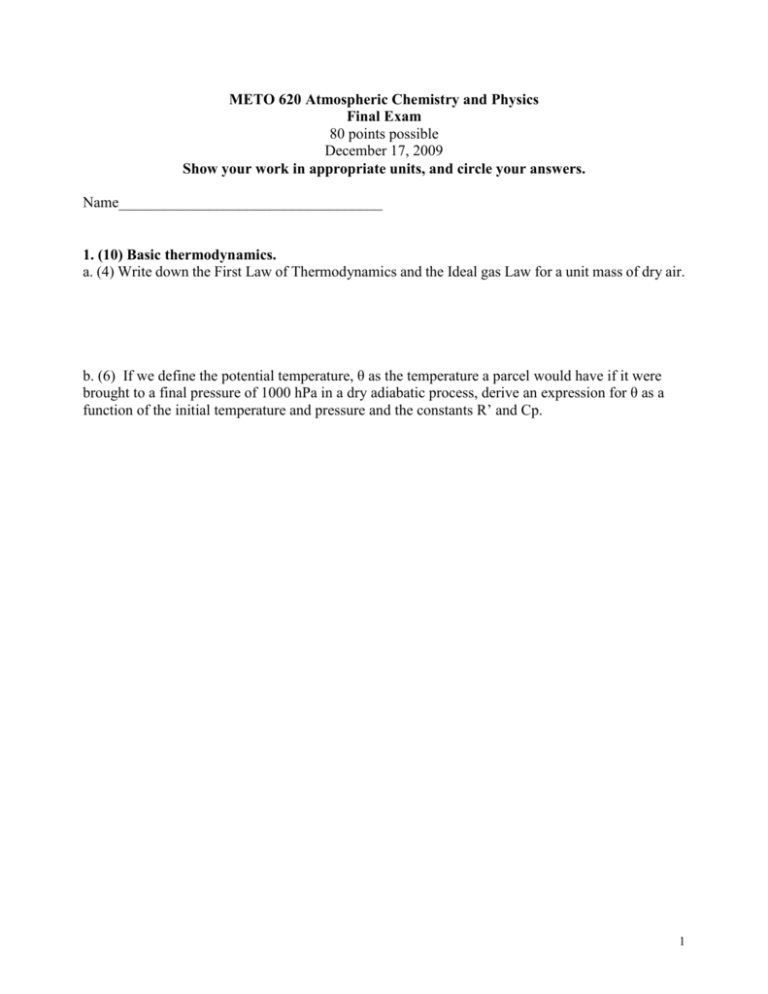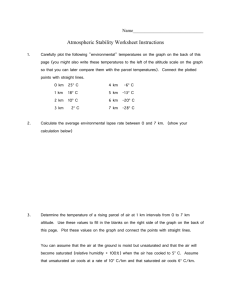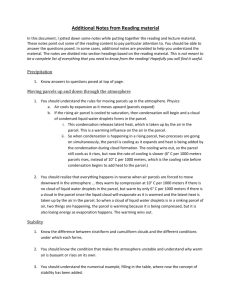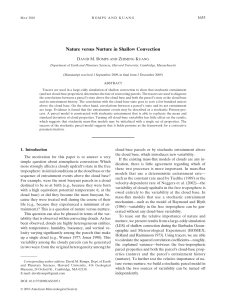Old Final Exam
advertisement

METO 620 Atmospheric Chemistry and Physics Final Exam 80 points possible December 17, 2009 Show your work in appropriate units, and circle your answers. Name___________________________________ 1. (10) Basic thermodynamics. a. (4) Write down the First Law of Thermodynamics and the Ideal gas Law for a unit mass of dry air. b. (6) If we define the potential temperature, θ as the temperature a parcel would have if it were brought to a final pressure of 1000 hPa in a dry adiabatic process, derive an expression for θ as a function of the initial temperature and pressure and the constants R’ and Cp. 1 2. (10) Thermodynamic Diagrams On the attached skew-T diagram sketch a sounding for a summer day that will generate either a severe convective storm or a severe smog episode. Label all important factors. 2 3. (10) Aerosols. a. (1) if the aerosol optical depth is 0.50 at 500 nm, what fraction of the direct beam of solar radiation reaches the Earth’s surface? b. (3) If a parcel of air has a scattering coefficient of 1x10-4 m-1 and an absorption coefficient of 0.25x10-4 m-1, both at 450 nm, what is the single scattering albedo at this wavelength? Comment on the likely composition of this aerosol. c. (6) The concentration of aerosols at the earth’s surface (assume sea level) is 15.0 g m-3 with an extinction efficiency of 5 m2g-1. The chemistry and physics of the particles do not change with altitude, but the concentration has an effective scale height of 2.0 km. You can estimate the extinction coefficient at the Earth’s surface and aerosol optical depth, if you make an important assumption. Make those estimates and explain any assumptions. 3 4. (10) Cloud processes. a. (2) Molecular diffusion limits in part the rate of condensation on cloud droplet. If D is the diffusion coefficient, derive an expression for the transport time for a distance of 1.00 m. Show units. b. (1) Qualitatively, how does the rate of molecular diffusion compare to vertical eddy diffusion? c. (3) Contrast growth of cloud droplets and rain formation by condensation vs. collision-coalescence. c. (4) Derive an expression for the partitioning of a slightly soluble substance in the gaseous and aqueous phases of a cloud at a fixed LWC and temperature and pressure. 4 5. (10) Global Biogeochemical Cycles Carbon monoxide (CO) is central to the oxidizing capacity of the atmosphere. The mean tropospheric mixing ratio [CO] is 100 ppb in the Northern Hemisphere and 60 ppb in the Southern Hemisphere. The main sources include fossil fuel combustion and oxidation of volatile organic compounds. The main sink is attack by OH. CO + OH → CO2 + H (4.1) a. (1) Estimate the global burden of CO in g. b. (3) Estimate the global mean lifetime. How (and why) will this vary season? c. (2) How is CO related to tropospheric ozone? d. (4) Derive an expression for the steady state concentration of CO assuming that the oxidation of CH4 is the only source of tropospheric CO and R4.1 is the only sink. CH4 + OH (+ O2) → products (4.2) Does the burden of CO depend on the OH concentration? Show whether this is the dominant source or that other sources of CO are important. 5 6. (10) Photochemistry and kinetics. Reactive nitrogen compounds destroy ozone in the stratosphere but form it in the troposphere. Explain how this can be so using appropriate reactions and kinetic arguments. 6 7. (10) Snow, ice and cold cloud microphysics. a. (2) Supercooled water is common in cold clouds, but high levels of supersaturation with respect to liquid water are not – explain. b. (4) A parcel of air at 540 hPa and 253 K contains 0.50 g/m3 of supercooled water. What would be the temperature change if that water suddenly froze? b. (4) Ice crystals grow in a manor analogous to liquid cloud droplets, but with a few differences. Which factors go into the differential equation for the rate of change of the mass of an ice crystal in an air parcel with sufficient water vapor? 7 8. (10) Cumulus Cloud Models. Cloud-resolving models start with the elementary parcel theory, but add in additional details. a. (2) If condensed water forms in the parcel, how does it change the buoyancy relative to elementary parcel theory? Write a quantitative formula if possible. b. (2) How does dilution by mixing change the stability of a parcel with respect to its surroundings, and the probability that future warm parcels will form deep convective clouds? c. (6) How can a convective cloud model be useful for quantifying the effects of changes in CCN concentrations on suppressing or enhancing precipitation in tropical and mid-latitude clouds? 8 POTENTIALLY USEFUL INFORMATION Molecular Weights H = 1.0 N = 14.0 S = 32.1 Br= 79.9 F = 19.0 O = 16 C = 12.0 K = 39 Cl= 35.5 R = 2.0 cal/moleK = 8.31 J/moleK; R’ = 287 J kg-1 K-1 N = 6.023x1023 molecules/mole. The mass of Earth’s atmosphere is 5.2E21 g 1 mole air = 22.4 L at STP. The mean atmospheric concentration of OH is ~106 cm-3. The Henry’s law coefficient for CO2 is 3.4 × 10−2 M atm-1. Mean sea-level surface pressure 1.013 x 105 Pa. L (273 K) = 2500 J g-1 R’/ Cp = 0.286 For Earth atmosphere Cv = 718 J kg-1 K-1 Cp = 1005 J kg-1 K-1 -1 -1 Cp (CH4) ~ 2000 J kg K . Cp (N2) = 1039 J kg-1 K-1. k(CH4-OH) = 3.7x10-15 cm3 s-1 at 273K. k(CO-OH) ~ 5x10-13 cm3 s-1 in the mid trop. Saturated vapor pressure es(T) ≈ 2.53E8 exp(-5.42E3/T) where the pre-exponential factor has units of kPa and the exponential factor has units of K. Plank’s Const h = 6.6 × 10-34 Js. The speed of light is 3.0x108 m/s. Species H2Og H2Ol O3 O NO NO2 NO3 H2CO HCO HNO3 Br HBr HCl CBr2Cl2 DMS CH2-S-CH3 Cl OH Hfo Gfo (kcal/mole) -57.8 -68.3 34.1 59.6 21.5 8.1 -5.47 -27.7 10.0 -32.3 26.7 -8.66 -22.1 -80 -20. 8.0 29.1 9.31 (kcal/mole) -54.63 -56.7 39.0 55.4 20.6 12.4 21.7 -26.3 8.0 -17.9 19.7 -12.72 -22.8 -85. -8.9 10.0 25.3 8.18 9 10









